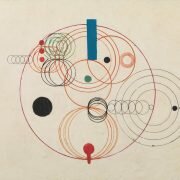Latin American Works on Paper at the Mayor Gallery
THE MAYOR GALLERY
21 Cork Street, First Floor, London W1S 3LZ T
+44 (0) 20 7734 3558 F
+44 (0) 20 7494 1377
www.mayorgallery.com
[email protected]
*
*
*
LATIN AMERICAN WORKS ON PAPER 9 JAN – 23 FEB 2018
The Mayor Gallery presents a group show of seven Latin American artists who were either born there or moved to join in the exciting and revolutionary art movements happening in the 50s and 60s. Conceptual and abstract art made in several Latin American countries from the late ’50s onwards dealt not only with questions of abstraction and constructivism but also with deeper cultural issues such as colonialism, repressive and dictatorial governments and social inequality. Their art is not just aesthetic expressions of creativity but a form of resistance to censorship and brutal regimes.
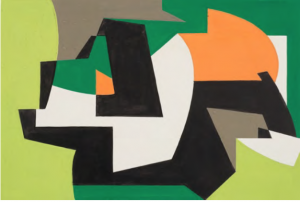
WIFREDO ARCAY
(b. 1925 Havana, Cuba – d. 1997 Paris, France)
Early 1950s gouaches on paper, painted in Paris, from the Artist’s Estate
Image: Untitled, 1950, gouache on paper, 16.5 x 25 cm
Born in Cuba and trained at Havana’s Academia de San Alejandro, Arcay arrived in Paris on a grant in 1949. He quickly assimilated within the milieu of post-Cubist Abstraction and in 1951, at the invitation of André Bloc, the influential editor of the journal Art d’Aujourd’hui, Arcay set up a studio at Bloc’s villa in Meudon, en countering such luminaries of the historical avant-garde as Jean Arp, Robert and Sonia Delaunay, and Fernand Léger. While celebrated as a printmaker, Arcay painted only through the 1950s and 1960s. He exhibited as part of the Cuban delegation to the São Paolo Biennale (1955) and frequently at Havana’s Galería Color-Luz, a pioneering outpost of geometric abstraction. A member of both the Constructivist Groupe Espace, founded by Bloc and Félix Del Marle in 1951, and the short-lived Cuban group Los Diez Pintores Concretos (1959-61), Arcay personified the rich diversity and internationalism of postwar abstraction.
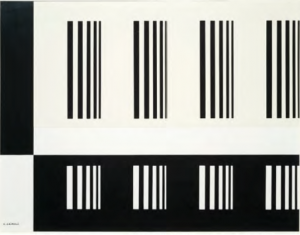
CARLOS CAIROLI
(b. 1926 Buenos Aires, Argentina – d. 1995 Chartres, France)
1950s to 1970s Collages and ink on paper, made in Paris, from the Artist’s Estate
Image: Rythme, 1963, collage, 65 x 50 cm
Cairoli studied fine arts in Buenos Aires where he met the artist Torres Garcia who familiarised him with theories of constructivism and the art of Mondrian. Interested by the effects of light on material, he joined the experimental group on spatial research directed by Lucio Fontana, who had returned to Buenos Aires (1946-47). Cairoli moved to Paris in 1952 exhibiting regularly. He participated in Groupe Espace created in 1951 by André Bloc and Félix Del Marle, both followers of De Stijl. This new group aimed to pursue in a less utopic approach the neo-plastic ideal of the synthetisation of the arts within an architectural space. Believing in a purer ideology and more universal form of constructivism, Cairoli joined in 1959 the Groupe Mesure with Georges Folmer, Luc Peire, François Morellet and Aurelie Nemours. He participated in the international exhibition at the Stedelijk Amsterdam Experiment in Constructie in 1962 regrouping the followers of De Stijl, including Jean Gorin, Anthony Hill, Joost Baljeu, Mary Martin and Charles Biederman.
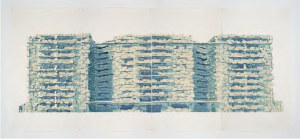
LOS CARPINTEROS
(Collective founded in 1992 Havana, Cuba)
Exhibition includes the largest watercolour on paper made by the Cuban collective
Image: Edifico Rio Mar, 2016, watercolour on paper, 200 x 452 cm
Marco Antonio Castillo Valdes, Dagoberto Rodríguez Sánchez and Alexandre Arrechea Jesus Zambrano (left in 2003) are the Cuban founders of the collective living and working between Havana and Madrid. Reflecting on the relatively recent Socialist revolution of their country under a regime of political economic crisis their work uses the imagery of man-made construction; cities, buildings, and swimming pools. ‘Edifico Rio-Mar’ shown here is a largescale reproduction of the infamous luxury apartment building in Havana that is now almost derelict. At a time when Cuba was introduced to the International Art World, in part by the birth of the Havana Biennial, the collective has had much success with many Solo and group shows throughout Europe and Mexico.
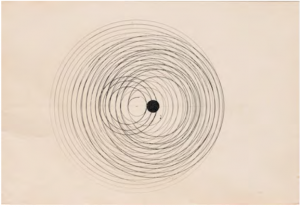
WALDEMAR CORDEIRO
(b. 1925 Rome, Italy – d. 1973 São Paulo, Brazil)
Rare 1940s early ‘50s Concrete pen and ink on paper from the Artist’s Estate
Image: Untitled, c.1950, ink on paper, 10.5 x 15.5 cm
Arriving in Brazil in 1946 Cordeiro settled in São Paulo in the following year initially working as a journalist, art critic and newspaper caricaturist. In 1949, Cordeiro participated in From Figurativism to Abstractionism, at the newly opened São Paulo Museum of Modern Art where abstraction gained institutional backing. He participated in the first São Paulo International Biennial in 1951 and in various subsequent ones. Cordeiro was Communist, his politics and art theory combined making him a proponent of art as a fundamental element of the social transformation process, firmly believing art should be accessible to all, rejecting the hedonistic idea of ‘art for art’s sake’. He promoted these ideals though public art projects and his landscape design company. As he wrote in the manifest of Grupo Ruptura founded in 1952 “Modern Art is not ignorance. We are against ignorance “. He followed closely Max Bill’s Concrete Art concepts and studied Visual Gestalt principles. Cordeiro wanted to produce a new Rational art through the use of simple elements; line and colour. From 1965 to 1968 he created work based on the principles of Opera Aperta (Umberto Eco) in the New Tendencies movement. Later, from 1969 to 1973 he introduced Computer Art to Latin America, a movement he called Arteonica which was for him a logical progression of Concrete Art.

